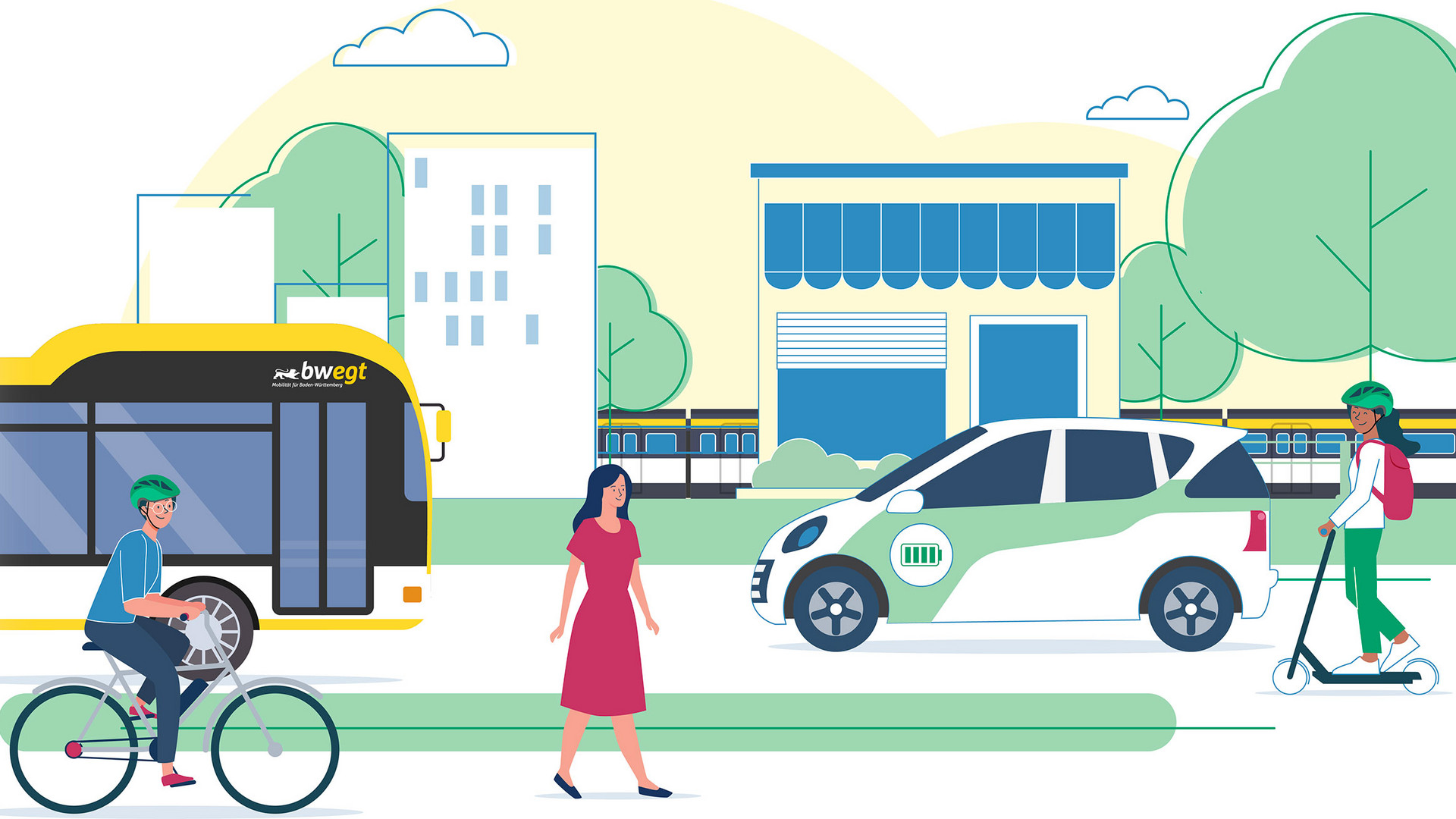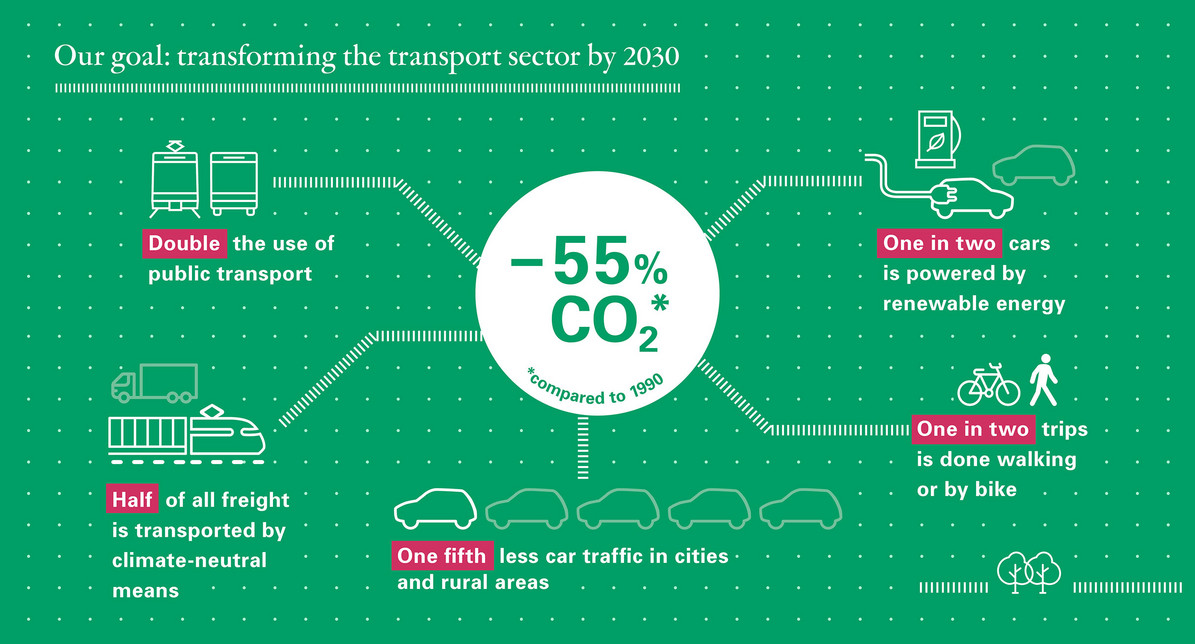In order to achieve the climate goals, much has to change. The transport sector in particular needs to undergo a transformation. The Mobility and Climate Concept of the State of Baden-Württemberg proposes concrete measures in this regard. This Concept is currently in development. The process is accompanied by participatory formats for citizens and stakeholders.
The climate change situation is serious. In the transport sector, the climate protection targets have not yet been achieved. On the contrary: carbon dioxide emissions have remained virtually unchanged in decades. To mitigate the consequences of climate change, much greater efforts are needed, and faster. The State’s target is to reduce transport-related CO2 emissions by 55 percent by 2030 compared with 1990 levels, and climate neutrality by 2040.
To achieve this target by 2030, more cars need to be powered by renewable energy and more freight must be transported by climate neutral means. In addition, the use of public transport must be doubled, car traffic in municipalities must decrease and more trips must be done walking or by bike.
The transformation of the transport sector is a challenge. The Ministry of Transport is therefore supporting society, the municipalities and companies in the region. In this context, it is important to set out clearly who is responsible for implementing which climate protection measures. The Mobility and Climate Concept defines these responsibilities and the financial aspects and also sets out the timeline.
Objectives of the Mobility and Climate Concept
The purpose of the Mobility and Climate Concept is to define measures to comply with the climate protection targets.
What the Concept intends to achieve:
- Implementation of the measures at State level and in the municipalities.
- Assurance of mobility for all, regardless of income, disabilities, age, background or gender, through the design of suitable measures.
- Compliance with the different mobility requirements in urban and rural areas.
- Provision of diverse and climate-friendly mobility options for the public and companies.
- Guarantee of an economically efficient use of public and private funds.
Areas of activity of the Mobility and Climate Concept
This sets out the most important measures for the transport sector to effectively implement the requirements of the Baden-Württemberg Climate Protection Act (BW CPA). The coalition agreement for Baden-Württemberg gave the mandate to develop this concept. The measures only represent a selection. The State’s Public Transport Strategy, for instance, already comprises 135 measures.
The Key Issues Paper (PDF) outlines six main areas of activity in line with the five transport sector transformation goals for Baden-Württemberg:
Around 2 million private and around 60,000 to 100,000 public charging points are to be created. The framework is to be developed at federal and EU level to make electric cars cheaper than fossil-powered cars. In addition, regional user benefits shall be provided for these vehicles; for instance, by the creation of zero-emission zones.
For freight transport, favourable competitive conditions in the interests of climate protection are to be created through a truck toll. The truck toll intends to protect local trade from rampant online trade and to provide incentives for climate-neutral trucks. Further expansions of the rail infrastructure, sustainable freight transport and effective city logistics are planned; for example, through the use of climate-neutral vehicles.
To reduce car traffic, the road space is to be upgraded, and mobility using sustainable means of transport is to be facilitated and strengthened. Cost-based parking management and car park repurposing will improve the public space. This will encourage more environmentally friendly transport and create more green space and gathering places. Car sharing services subject to high quality standards are to be available throughout the region.
By 2030, the share of trips by bike should have increased from 10 percent to 20 percent and those done walking from 21 percent to 30 percent. For this purpose, the expansion of 7,000 kilometres of Baden-Württemberg’s cycle path network is expected to reach the target state by 2030. This will be supplemented by 20 express cycle paths. A pedestrian-friendly infrastructure for compact cities will be supported by state funding programmes for municipalities.
The public transport offering is to be improved and capacities increased. In addition to improving the reliability and speed of train and bus travel, a considerable expansion of services, both in terms of timetabled services and frequency, is intended to ensure a reliable service in the region as a whole. This service includes off-peak times and weekends and is assured by a mobility guarantee between the hours of 5:00 a.m. to midnight. During off-peak times and in regions with little public transport, flexible and on-demand transport services supplement the public transport offering. It is intended that the transport associations will offer passengers simple, understandable and attractive fares.
A transformation of the mobility culture and comprehensive transport planning are required to realise other areas of activity. This will be supported by climate mobility plans for cities and districts as well as action plans for small municipalities. At all planning levels, spatial and settlement development should be focused on reducing traffic. For the transformation of the transport sector and its planning, in particular, it will be necessary to recruit sufficient, suitably qualified personnel.
Involvement of the public
Citizens and stakeholders in Baden-Württemberg were invited to participate in the process. They were able to incorporate new suggestions and insights into the Concept to improve its quality, acceptance and implementation. Randomly selected citizens discussed the Concept in a ‘mobility council’. All citizens of Baden-Württemberg were given the opportunity to have their say online on the State’s participation portal. Associations were also invited to contribute their ideas and recommendations.


